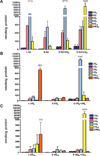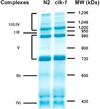The role of DMQ(9) in the long-lived mutant clk-1
- PMID: 21745495
- PMCID: PMC3156029
- DOI: 10.1016/j.mad.2011.06.009
The role of DMQ(9) in the long-lived mutant clk-1
Abstract
Introduction: Ubiquinone (UQ) is a redox active lipid that transfers electrons from complex I or II to complex III in the electron transport chain (ETC). The long-lived Caenorhabditis elegans mutant clk-1 is unable to synthesize its native ubiquinone, and accumulates high amounts of its precursor, 5-demethoxyubiquinone-9 (DMQ(9)). In clk-1, complexes I-III activity is inhibited while complexes II-III activity is normal. We asked whether the complexes I-III defect in clk-1 was caused by: (1) a defect in the ETC; (2) an inhibitory effect of DMQ(9); or (3) a decreased amount of ubiquinone.
Methods: We extracted the endogenous quinones from wildtype (N2) and clk-1 mitochondria, replenished them with exogenous ubiquinones, and measured ETC activities.
Results: Replenishment of extracted mutant and wildtype mitochondria resulted in equal enzymatic activities for complexes I-III and II-III ETC assays. Blue native gels showed that supercomplex formation was indistinguishable between clk-1 and N2. The addition of a pentane extract from clk-1 mitochondria containing DMQ(9) to wildtype mitochondria specifically inhibited complexes I-III activity. UQ in clk-1 mitochondria was oxidized compared to N2.
Discussion: Our results show that no measurable intrinsic ETC defect exists in clk-1 mitochondria. The data indicate that DMQ(9) specifically inhibits electron transfer from complex I to ubiquinone.
Copyright © 2011 Elsevier Ireland Ltd. All rights reserved.
Figures






References
-
- Arroyo A, Santos-Ocana C, Ruiz-Ferrer M, Padilla S, Gavilan A, Rodriguez-Aguilera JC, Navas P. Coenzyme Q is irreplaceable by demethoxy-coenzyme Q in plasma membrane of Caenorhabditis elegans. FEBS Lett. 2006;580:1740–1746. - PubMed
-
- Beal MF. Mitochondrial dysfunction and oxidative damage in Alzheimer's and Parkinson's diseases and coenzyme Q10 as a potential treatment. J Bioenerg Biomembr. 2004;36:381–386. - PubMed
-
- Crane FL. Discovery of ubiquinone (coenzyme Q) and an overview of function. Mitochondrion. 2007;7 Suppl:S2–S7. - PubMed
-
- Doonan R, McElwee JJ, Matthijssens F, Walker GA, Houthoofd K, Back P, Matscheski A, Vanfleteren JR, Gems D. Against the oxidative damage theory of aging: superoxide dismutases protect against oxidative stress but have little or no effect on lifespan in Caenorhabditis elegans. Genes Dev. 2008;22:3236–3241. - PMC - PubMed
Publication types
MeSH terms
Substances
Grants and funding
LinkOut - more resources
Full Text Sources

